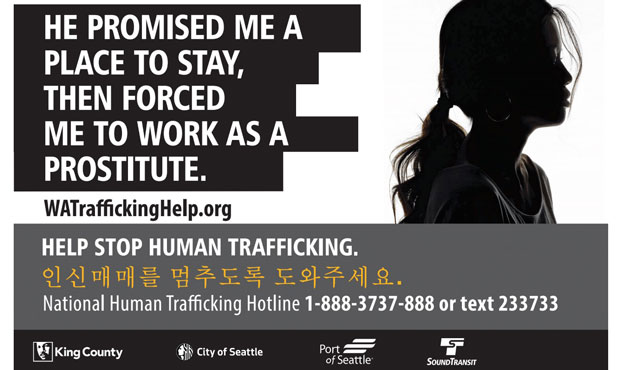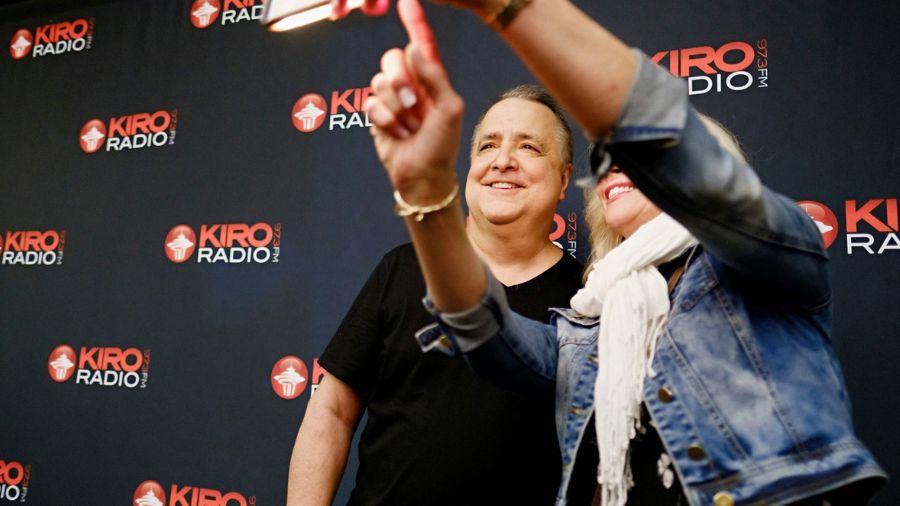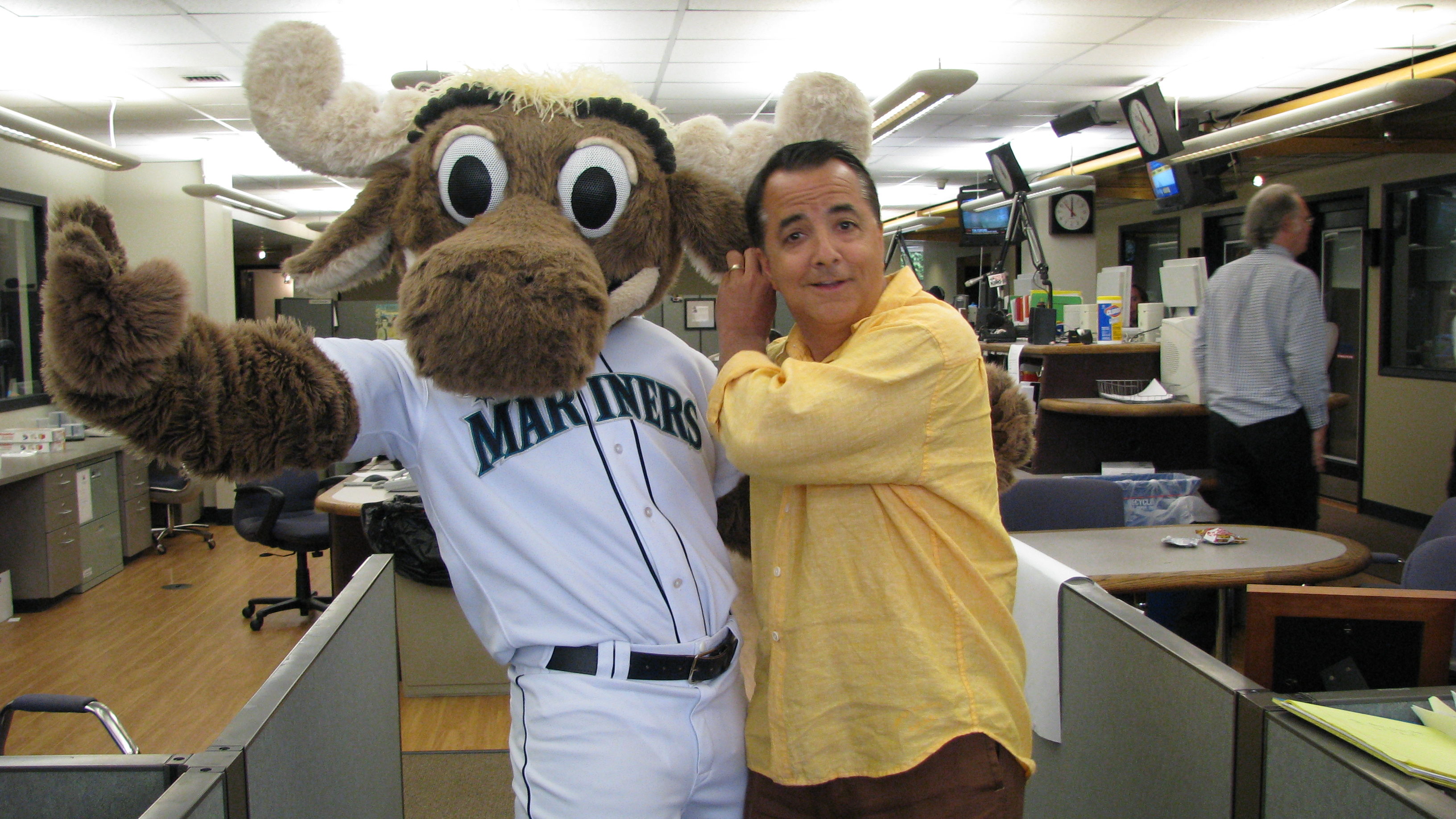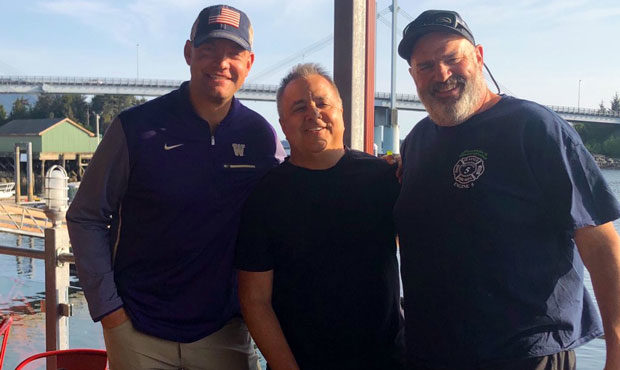Travelers may play key role in busting human trafficking
Apr 17, 2019, 11:52 AM | Updated: 12:16 pm

The campaign to raise awareness of human trafficking at Sea-Tac means that posters like this can be found throughout the airport. (Photo courtesy of Businesses Ending Slavery and Trafficking)
(Photo courtesy of Businesses Ending Slavery and Trafficking)
Though we may not realize it, human trafficking is all around us every day. Police estimate that as many as 500 youth are being trafficked in King County at any given time.
And it’s the subject of the current campaign at Sea-Tac Airport, launched in January by a partnership between the Port of Seattle, City of Seattle, King County, Sound Transit, Delta Airlines, Alaska Airlines, and Businesses Ending Slavery and Trafficking (BEST).
RELATED: Child sex trafficking — as easy in Seattle as ordering a pizza
The campaign features posters throughout Sea-Tac — as well as on trains, buses, at law enforcement offices, doctors’ offices, and even libraries — reminding people of the prevalence of trafficking.
“This is the first campaign that I know about, in the U.S., where you have such a variety of government agencies working together to raise awareness about trafficking,” said Mar Brettmann, founder and director of BEST.
As part of this mission, BEST trains Sea-Tac employees to recognize signs of human trafficking so that they will feel comfortable speaking up if they notice anything.
“One of the biggest ways the port can be involved is by raising awareness, and also becoming a property where, when people are trafficked, they know that they can access help and services,” Brettmann said.
But it goes beyond just airport employees — the goal of the campaign is for travelers passing through the airport to spot potential victims. After all, as a center of transportation and a doorway to both the rest of the country and the rest of the world, airports can be a common place for trafficking victims.
“The Port of Seattle, cruises, bus lines, all of it, they play a huge role in moving people around,” said Kyra Doubeck, a human trafficking survivor, advocate, and behavioral specialist with Kent Youth and Family Services.
Just last week, police rescued a trafficking victim who had escaped her captors at Colman dock, Seattle’s local ferry terminal.
Doubeck said that when people think of human trafficking, they often mistakenly think of smuggling — bringing in people from other countries hidden in ships. Really, she explained, trafficking at an airport tends to happen when people who are already in the country are moved by their trafficker to work in other places.
“Sometimes, [traffickers] assume that there is more money to be made in different cities,” she said. “So you’ll go through the airport — you’ll fly there … and we’ve got an international port, I think that’s what makes us a hotbed. We’ve got a border with Canada, we’re along the I-5 corridor, it’s really easy to travel between Canada and California.”
Signs to look out for
But how does one know when it’s appropriate to speak up? Earlier this year, Cindy McCain, wife of the late Sen. John McCain, said that she contacted police to report trafficking after spotting an adult and child of two different races at Phoenix Sky Harbor International Airport. Phoenix police reportedly investigated the matter and found no evidence of trafficking.
Experts say that vigilance is encouraged, but looking purely at race is not. While statistics show that trafficking overwhelmingly does victimize groups that are already marginalized, such as racial and ethnic minorities, women, and the LGBT community, one should look beyond just outward physical appearance.
“It’s not always people who are dressed a certain way, or things like that, and it’s not always, for example, an African-American man with a white woman,” Doubeck said. “There are white pimps, there are female pimps, there are male, transgender, and female victims of prostitution — it doesn’t discriminate on race or gender identifiers, or sexual orientation.”
So what should travelers look at if not physical traits?
“We advise people not to look at race or gender, but instead to look at behaviors,” Brettmann stressed.
These behaviors should be fairly obvious, Doubeck said. A human trafficking victim should stand out from others moving through an airport by seeming disoriented, completely unprepared for travel, and dependent on another person with them (the trafficker).
“They have none of their own money. There’s some unusual bruising on someone’s arm,” she said. “Just something seems off, gravely off … maybe they have no personal belongings or bags, they have no luggage.”
Brettmann said that typical red flags would be “someone or a group of people who won’t make eye contact, sort of in an unusual manner, or if they are not able to speak for themselves — if someone is controlling them, if someone is doing all the speaking for them.”
A prime location to spot traffickers and their victims is in the security line.
“Are they in control of their travel documents, or do they look comfortable with the person who is in control of their travel documents?” Brettmann said.
According to Doubeck, pimps will take their victims’ identification as a long-term way of holding them hostage and maintaining control over them.
A state of discomfort or fear should also be noted. This distress looks different from typical travel anxiety or jet lag, Brettmann explained. Watch for someone who looks like they’re being coerced, with “a sort of level of fatigue that is pretty extreme.”
Doubeck added that human trafficking victims are far less clued-in about their travels than other people taking a flight typically would be.
“They don’t seem to know where they are. They don’t know that they’re in Seattle, Washington, and they don’t know that they’re traveling to Vegas, or they don’t know where their destination is,” she said. “They don’t seem to be quite aware of what exactly is going on, and they don’t know how long they’re going to be there … those are some pretty big signs that something is not quite right.”
Don’t just keep an eye on the victim either — check the surrounding area, especially if the victim or victims don’t appear to be accompanied by a trafficker at first glance. The trafficker could be standing in the background as a guard, “watching a person, making sure they’re doing what they’re supposed to do,” Brettmann said.
“They’re not free to walk over to a vending machine, or if they go to the bathroom, they have to go in a group with somebody, if they’re allowed to go to the bathroom,” Doubeck said.
When in doubt, she said, speak up. You could be saving a person’s life.
While there is a common misconception that some women choose to be prostitutes, Doubeck said that nearly all of the women in the sex industry have been lured there by manipulative traffickers after growing up in a vulnerable situation. Traffickers keep victims enslaved through violence, brainwashing, and cutting them off from money, communication, food, and even sleep.
If you believe you see a human trafficking victim, and if it appears to be an emergency or if a child is involved, call 911 immediately. Otherwise, try to talk to the victim and, if they express a need for help or confirm they are being trafficked, pass along the National Human Trafficking Hotline number, 1-888-373-7888, which has interpreters for many different languages, and can put victims in immediate contact with resources.
However, if you believe the trafficker is present with the victim, do not approach them under any circumstance; Brettmann and Doubeck said that traffickers have the potential to be very dangerous.
“If there’s a trafficker present, call either that hotline or call 911,” Brettmann said. “We don’t ever advise a bystander to try to get involved in a trafficking case.”
Tech and trafficking
Some reports have shown that Seattle has one of the highest-increasing rates of sex trafficking in the nation. About 6,800 people are soliciting sex every 24 hours in our region, according to BEST.
In fact, according to one Microsoft data analyst, there were just as many commercial sex advertisements — 300,000 — in Seattle, as in New York City in 2016, despite a population difference of nearly 8 million people.
“Our demand for people to be in the sex trade is growing over the last 10 years, and that’s probably because of an increase in high-paying jobs in this community,” Brettmann said. “We probably have an increase in supply as well, in order to meet that demand. This is a market driven by money, and unfortunately, it’s the commodification of people’s bodies that are being used.”
Brettmann said that buyers tend to be white, well-educated, and wealthier than the average King County resident.
“That’s a lot of the workforce that’s been brought into our county with the boom of the tech industry,” she remarked.
Doubeck remembered that when she was trafficked, most of her buyers were “middle-aged, married, had good jobs at reputable companies … men in business clothes.” Many of them had jobs in the tech industry. If you saw them on the street, she said, you would have every reason to think they were upstanding citizens.
“We’ve got this system of power and privilege that’s prevalent within the system of commercial sex,” Doubeck said.
When businessmen who like to buy sex in their free time come to Seattle on a work trip, they look at sex ads online to arrange a meeting on their week out of town. Doubeck compared it to “going on Amazon and looking at a pair of leggings or a coffee pot.” There are even ways to review the people being trafficked, like a person would review a product on Amazon.
“Buyers talk to each other, so they know what websites to go on,” Doubeck said.
The Port of Seattle said that it is too early to know how many people the new campaign has helped. There are no known numbers as to how many trafficking victims travel through Sea-Tac every year.
However, Doubeck estimated that the number of people either being trafficked and passing through the airport or coming to Seattle to buy sex could be in the thousands.
“If we look at … every person that travels through the airport and how demanding the sex trade is, and how high the demand is, there are probably thousands of people who travel through our airport every year, either because they’re being trafficked or because they’re coming here to buy sex,” she said.













